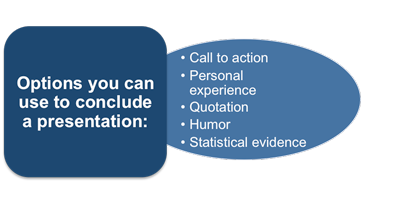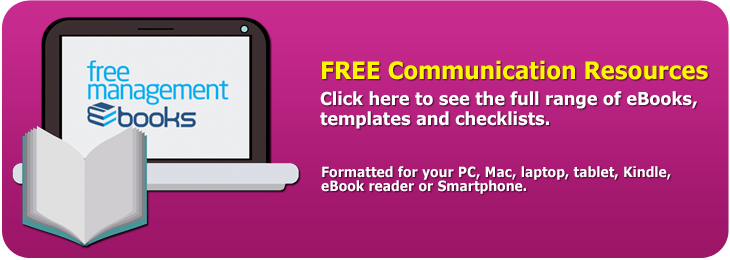Communication Skills - Question and Answer Session
The final part of most presentations is the 'Question & Answer' session (Q&A) - a planned session allocated to questions from the audience. The Q&A normally follows the conclusion, where you assert yourself as the center of attention, delivering with confidence, enthusiasm, and authority.
Ideally the conclusion should represent about 10 percent of the overall presentation. Your last visual aid should summarize the main message of the presentation and be left up as you answer questions. You can emphasize this transition by moving towards the audience, raising or lowering your voice, or perhaps pausing for a few seconds to look at your notes. This will increase the audience's capacity to retain the key message.
The impression you make at this point with the audience will be the lasting one and your last words the most remembered. So always plan a strong finish and make sure it is short and to the point.
 |
Your conclusion should clearly indicate the end of your presentation, allowing the audience time to frame any relevant questions. If the ending just appears out of the blue you are likely to be met with stony silence. Whilst you may initially welcome the lack of questions it can often leave the lasting impression that no one was really interested in the content or thought it was important.
A few good questions at the end of the presentation can sometimes make up for any oversights you have made when developing the content. Even though you can try to cover the points that you feel people will be interested in you can not always do this in a way that really resonates with them.
Sometimes people will get more from the answers to some questions at the end than they will have got from your presentation as a whole simply because the questions were phrased in a way that made sense to them from their perspective.
Plan for the transition to the Q&A session in the same way you have planned the rest of your presentation. When you have your final content, read through it carefully and note any questions that it is likely to raise, and prepare answers to these in advance. Focus on any areas in which your message is short of facts or vulnerable to being challenged. This will help you to anticipate most questions that are likely to arise, as well as prepare more lengthy answers in advance for questions you are sure will be raised.
Make sure your answers to any queries are helpful and informative, thus helping you to retain control. Some common ways to manage this transition and get questions flowing are:
- Have noted on a flip chart questions as they arose during the presentation and answer them in turn. (Eliminate any early questions that the latter part of your presentation answered.)
- If you have a chairperson agree with them beforehand that they will intervene and ask some initial questions in an attempt to involve your audience.
- Have someone in the audience primed to ask a simple question.
- Ask the audience if there is anyone who can relate to or has practical experience of an item discussed in the presentation and if their experience was the same or similar.
Remember, even people who do have questions may not want to be the first to speak up. In some instances it is equally likely that you are just facing an unresponsive group. This may be due to the character types within it or the intra-group politics.
When answering questions speak clearly and confidently, otherwise you will appear unsure of what you are saying. Do not let nerves draw you into responding hastily, always think about your answer before you speak, and if necessary refer back to your notes in order to answer a question.
If the question requires clarification then ask the questioner to do this, rather than risk answering a question that wasn't asked. When answering, address the entire audience and not just the questioner, and avoid getting into a protracted debate on any point that is raised - you may offer to see a questioner after the presentation to continue a point that is of specific personal interest to them.
You may face questions that are unanswerable. These may be posed by people who are hostile to your message or by those just wishing to make a point. If you feel unable to answer a question you may find it useful to have a standard reply ready in order to reduce its impact on your presentation. Here are some useful examples:
'I need to check with my colleagues before I can answer your questions so please see me after the session. I will take your details and get back to you.'
'Let me think about that for a minute. Can we come back to it later? Next question please.'
'I don't think that the information necessarily supports either view definitively. However my personal opinion is that . . .'
When you have reached the limits of your time you need to draw the Q&A session to an end. It is extremely important to thank everyone for their questions and for giving up their time to listen to you. If several people still have questions at this point you can give them your email address and ask them to send their question to you so you can reply to it.
You may also be interested in:
Giving a Management Presentation | Styles of Presenting | Cue Card Guidelines | Developing a Persuasive Delivery Style | How to Rehearse | Reading Your Audience | Retaining Control in a Presentation | Importance of the Presentation Venue | Presentation Venue Layout.



